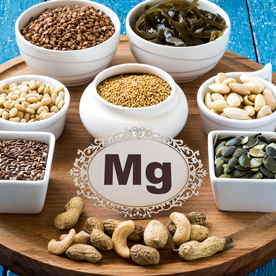
Many women experience period pain at some point in their lives. In the medical professional world, period pain is referred to as ‘dysmenorrhoea’ or, more commonly, menstrual cramps – and is normal. Although this monthly pain is considered normal, it can range from mild discomfort to often severe, debilitating pain. For an estimated one in four women, period pain can be so severe it interferes with their daily lives and activities.i
 While it is common, period pain – especially when it’s severe on a regular basis – could also be a sign of a more serious underlying condition. There are certain lifestyle factors that may also make you more likely to experience severe period pain. For instance, it’s more common in women aged 20 and younger and in those who started puberty before they reached the age of 11. Smoking, obesity, alcohol, anxiety and depression have all also been linked with period pain.
While it is common, period pain – especially when it’s severe on a regular basis – could also be a sign of a more serious underlying condition. There are certain lifestyle factors that may also make you more likely to experience severe period pain. For instance, it’s more common in women aged 20 and younger and in those who started puberty before they reached the age of 11. Smoking, obesity, alcohol, anxiety and depression have all also been linked with period pain.
But what is period pain exactly? Here’s what should you know about your period pain to understand your symptoms, the causes and the possible conditions your period pain could be a sign of.
What are the symptoms?
Most women are familiar with that unpleasant dull or throbbing pain in the lower abdomen, just above the pelvic bone, when their period starts. But period pain can be accompanied by other symptoms too, including nausea, diarrhoea, vomiting, headache, lightheadedness, dizziness, bloating and fatigue. The pain in your abdomen may also spread to your lower back and thighs.
Period pain can start a few days before your period – though most women find it begins when their period starts. Typically, it lasts for two to four days, or longer in some cases, with the pain usually being at its peak when your period is at its heaviest.
There are two different types of pain: spasmodic period pain is that intense, featuring cramps or a described ‘stabbing’ feeling in the lower abdomen that comes and goes in waves; while congestive period pain is a more continuous dull ache. Period pain can also vary from month to month, and sometimes you may get little to no discomfort, then the next month your period may be painful.
What causes it?
Period pain is caused by contractions in your uterus (womb). During your period, the muscular wall of your uterus tightens so that it can shed its lining – the endometrium – which leaves your body through the vagina. This happens when the egg your ovary released during ovulation remains unfertilised, meaning you’re not pregnant, and the lining of the uterus is no longer needed (if the egg is fertilised it embeds itself in the lining, which thickens each month to prepare for pregnancy).
Strong contractions are thought to cause pain because they interfere with the blood flow to the uterus.ii When the uterus contracts forcefully, it can press against blood vessels in that area, which stops the supply of blood briefly. With no blood flow, the oxygen supply is cut off too. And without oxygen, the tissues in the uterus release chemicals that trigger pain.
Other chemicals called ‘prostaglandins’ are also thought to be related to period pain.ii While your uterus is releasing pain-triggering chemicals, it produces prostaglandins to encourage the contractions. We don’t know why but it’s thought that some women don’t make or store large amounts of prostaglandins, which means their uterine contractions aren’t very strong. But if you’re among those who do produce high levels of prostaglandins, it usually means your contractions are more powerful – and that can lead to more severe aches and cramps.
Prostaglandin levels are also higher at the beginning of your period then become gradually lower as your period progresses. This may explain why the pain is usually worse at the start of your period and becomes milder over the next few days.
Underlying causes
When period pain is caused by high levels of prostaglandins it’s classed as primary dysmenorrhoea.iii This is thought to be the most common type of period pain, and usually improves as you get older and with having children (it most often starts when you’re a teenager or in your early 20s). If you have secondary dysmenorrhoea, it might mean your period pain is related to an underlying condition. This type of period pain can start earlier in your cycle and may also last longer than with primary dysmenorrhoea.
Secondary dysmenorrhoea is most common in women over the age of 30. Some of the conditions that can cause it include the following:
Endometriosis
With endometriosis, cells that are normally found in the lining of the uterus start growing on other organs in the pelvis. This causes extreme period pain when they are shed. As a result, the symptoms of endometriosis can often be confused with PCOS. To find out how to differentiate between PCOS and endometriosis, see our guide to understanding the difference.
Fibroids
Can also make periods painful, fibroids are non-cancerous tumours that develop within the wall of the uterus.
Pelvic inflammatory disease
PID is a bacterial infection of the fallopian tubes (and also sometimes the uterus, ovaries and cervix), which causes severe inflammation.
Adenomyosis
This is when the endometrium starts growing within the muscular wall of the uterus, again causing very painful periods.
Other things that can cause secondary dysmenorrhoea include an ovarian cyst or tumour, endometrial polyps, sexually transmitted infections (STIs) and the use of an IUD contraceptive device. Last but by no means least, secondary dysmenorrhoea can be caused by polycystic ovary syndrome (PCOS).
PCOS
If you have heavy bleeding and clotting along with severe period pain, it could be a sign that you have PCOS. But there are other symptoms of PCOS that are even more specific, such as irregular periods – often leading to fertility problems – excess facial hair, oily skin, acne and weight gain. If you’re also experiencing any of these symptoms – or indeed if you have severe period pain on a regular basis – it’s a good idea to see your GP so they can investigate whether or not your symptoms are caused by an underlying condition.
To find out more about PCOS, including the signs and symptoms to look out for, read Polycystic ovary syndrome: understanding your condition.
How to treat period pain
Whether your period pain is primary or secondary, there are things you can do that may relieve your symptoms and help you get on with your life.
For most women, period pain can be treated at home with over-the-counter painkillers, particularly the type that also act to reduce inflammation. One anti-inflammatory painkiller you may want to try is ibuprofen. However, remember to always take it with food to protect your stomach lining.
Aspirin is another anti-inflammatory, but this isn’t recommended often by health professionals these days, as it’s thought to irritate the stomach more than ibuprofen. According to the NHS you could also try paracetamol, but it’s thought to be less effective at reducing period pain than ibuprofen or aspirin.ii
Meanwhile if over-the-counter painkillers aren’t effective and you’re still experiencing pain, your GP may decide to prescribe a stronger painkiller for you.
If you suffer from particularly painful periods, your GP may also suggest you take the contraceptive pill. This is thought to be effective because it keeps the lining of the uterus thin and reduces your body’s production of prostaglandins. The added advantage of taking the pill is that your periods will be lighter. Another contraception method called an IUS (often referred to as the coil) may help with period pain too.
Meanwhile there are several drug-free ways of coping with period pain, including the following:
Nutrition
Eating healthily is always a good idea, whatever your symptoms, as it helps support all your body’s systems. Avoiding pro-inflammatory foods – such as red meat, sugar, dairy foods and alcohol – may help relieve period pain. Instead, try eating oily fish, which contains anti-inflammatory omega-3 fatty acids. There is even some evidence that fish oil is better than ibuprofen in treating severe period pain in primary dysmenorrhoea.iv Also try a cup of chamomile tea, as it’s thought to contain increased levels of glycine, an amino acid known to relieve muscle spasms.v Find out more about how hormone-happy foods can help to alleviate the symptoms of PCOS.
Heat therapy
A hot water bottle held against the abdomen may bring relief, or you can buy heat pads that you wear under clothes. Alternatively, take a warm bath or shower.
Magnet therapy
Magnets are often used by alternative practitioners as natural painkillers, and many use them for period pain too. Applied to the lower abdomen, they help the muscles relax and help improve blood flow in the area, both of which may help stop cramping.
Yoga
The last thing you probably feel like when you’ve got period pain is exercise, but many doctors agree it can help as it improves blood flow. Yoga is ideal, as several poses improve circulation in the abdominal area. However, inverted poses, such as the shoulder stand or headstand, should be avoided if you’re having your period.
Acupuncture
Apply pressure to what acupuncturists call the Liver 3 acupressure point (the area between the bones between your big toe and the second toe, around a centimetre below the two toes).
For more information on dealing with your PCOS symptoms and to understand your condition, explore the rest of our hub.
References:
-
Grandi, G., et al. Prevalence of menstrual pain in young women: what is dysmenorrhoea? J Pain Res. (2012). ;5: 169–174. . Available online: https://www.ncbi.nlm.nih.gov/pmc/articles/PMC3392715
-
NHS. Period Pain. NHS. (2016). Date accessed: 29/05/2018. Available online: https://www.nhs.uk/conditions/period-pain
-
Harding, M., et al. Period Pain: Dysmenorrhoea. (2018). Date accessed: 29/05/2018. Available online: https://patient.info/health/periods-and-period-problems/period-pain-dysmenorrhoea
-
Zafari, M., Behmanesh, F., Mohammadi, A.A. Comparison of the effect of fish oil and ibuprofen on treatment of severe pain in primary dysmenorrhea. Caspian J Intern Med. (2011 Summer). ;2(3): 279–282. Available online: https://www.ncbi.nlm.nih.gov/pmc/articles/PMC3770499
-
Tea off to good health,. Imperial College London . Available online: https://www.imperial.ac.uk/college.asp?P=5913
Related Posts?
Disclaimer: The information presented by Nature's Best is for informational purposes only. It is based on scientific studies (human, animal, or in vitro), clinical experience, or traditional usage as cited in each article. The results reported may not necessarily occur in all individuals. Self-treatment is not recommended for life-threatening conditions that require medical treatment under a doctor's care. For many of the conditions discussed, treatment with prescription or over the counter medication is also available. Consult your doctor, practitioner, and/or pharmacist for any health problem and before using any supplements or before making any changes in prescribed medications.

Olivia
Olivia Salter has always been an avid health nut. After graduating from the University of Bristol, she began working for a nutritional consultancy where she discovered her passion for all things wellness-related. There, she executed much of the company’s content marketing strategy and found her niche in health writing, publishing articles in Women’s Health, Mind Body Green, Thrive and Psychologies.
View More



